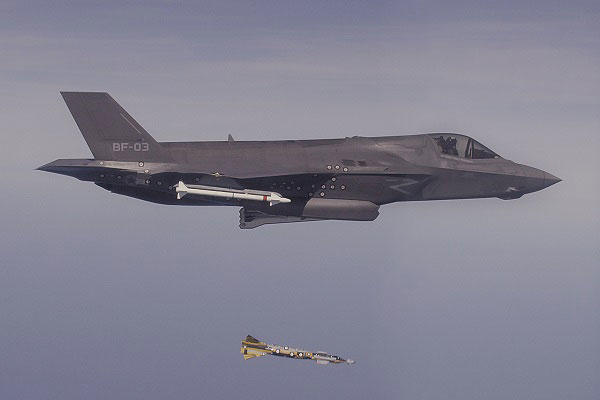The Royal Air Force's F-35B has successfully tested a weapons separation of a high-tech Paveway IV bomb over the Atlantic Test Ranges in Patuxent River, Maryland, according to the Pentagon's F-35 office.
The bombs were unarmed during the testing as the objective was to demonstrate that the weapon could successfully launch from the internal weapons bay of the F-35B, the Marine Corps' short-take-off-and-landing F-35B also used by the British Royal Navy.
"The joint U.S.-U.K. test team aced the weapons separation test of the first all-weather, dual inertial navigation- and GPS-guided bomb operational on the F-35, a major milestone for the U.K. Royal Navy and RAF F-35 program," a U.S. F-35 program office statement said.
The point of the demonstration was to ensure that the safe separation of the weapon from the aircraft could be done in a way that preserved the platform's stealth properties.
The U.K. Paveway IV, a guided 500-pound air-dropped weapon, first entered combat in 2008, according to a statement from the British Ministry of Defense.
Related Video
The cockpit-programmable weapon allows the aircrew to select weapon impact angle, attack direction and fuzing mode to detonate in the air, upon impact or in post-impact delay mode, an MOD statement explained.
"The fuze minimizes collateral damage through the ability to detonate the weapon when buried or partially buried, and it is fitted with a 'late-arm' safety functionality that will not allow an off-course munition to arm," the statement explained.
The Paveway IV is a lighter variant of earlier Paveway weapons, which allows a single aircraft to carry more weapons and strike more targets on a single mission.
"The weapon can be reprogrammed with target data by the aircrew while airborne by using data from onboard sensors or from forward air controllers on the ground. Paveway IV also retains the legacy laser guidance capability of its predecessors," the MOD statement added.
Meanwhile, in November of last year, the U.S. Joint Strike Fighter completed three live-fire weapons delivery accuracy tests involving two AIM-120 Advanced Medium Range Air-to-Air Missiles, or AMRAAMs, and one Joint Direct Attack Munition, or JDAM.
"These events included the first supersonic-guided missile launch and the first JDAM release on target coordinates generated from the Electro-Optical Targeting System," a JSF program office statement said.
The F-35 can carry more than 3,500 pounds of ordnance in low observable or stealth mode and over 18,000 pounds uncontested.
There are 11 weapons stations built onto the F-35 airframe. Four of them -- weapons stations four, five, seven and eight -- are internal weapons stations engineered to allow the aircraft to fly and drop weapons while in stealth mode, JSF officials said.
A separation process and extensive evaluations involving testing weapons "drops" typically take place before weapons are live-fire tested against targets, JSF officials said.
F-35 weapons separation testing has also involved the GBU-39 Small Diameter Bomb and external "flutter tests" with the AIM-132 Advanced Short Range Air-to-Air Missile.
The Marine Corps F-35B is slated to deploy aboard a Navy amphibious assault ship by 2018.
-- Kris Osborn can be reached at Kris.Osborn@military.com.



























